Dealing with rust is never fun, but sometimes it’s necessary. If your microwave shows signs of rust, don’t worry – there are a few ways to fix the problem. This blog post will cover how to fix rust inside microwave. We’ll also talk about some prevention tips so you can avoid this issue in the future. Let’s get started!
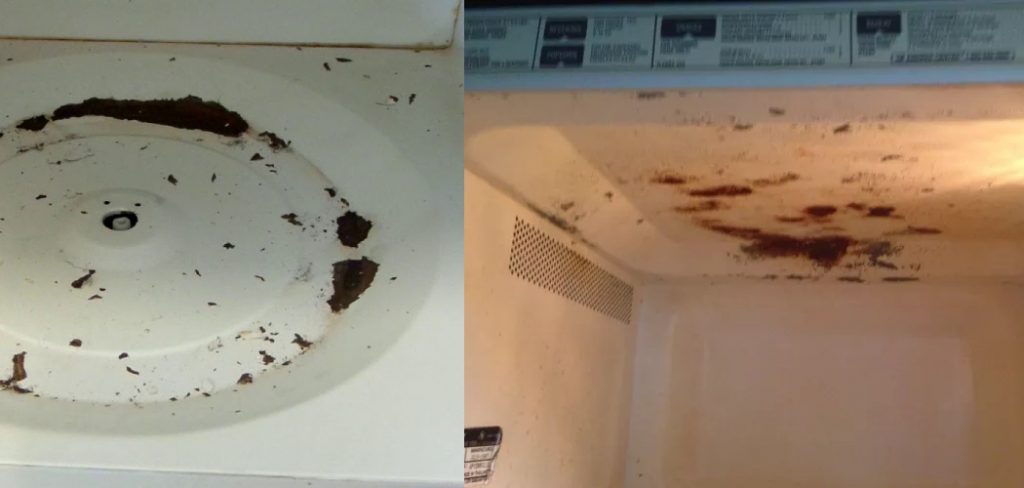
Summary: To fix rust inside a microwave, start by unplugging the appliance and removing any food or containers. Then, take out the internal components, such as the glass plate and cover plate. Dip a rag in white vinegar and rub it on the rusted area until the rust is removed. Finally, reassemble the internal components and plug in your microwave again.
What Causes Rust in Microwaves?
There are a few different things that can cause rust in microwaves. One common cause is water damage. If your microwave has been damaged by water, it’s more likely to develop rust. Another common cause is food splatter. Over time, food splatter can cause rust to form inside your microwave. This can be a big problem if you don’t clean your microwave regularly.
Additionally, some microwaves are just more prone to rust than others. If your microwave is made of metal, it will likely develop rust over time. The other major cause of rust is improper care. If you don’t clean or maintain your microwave properly, it will likely develop rust. Lastly, certain chemicals can cause rust to form inside microwaves. If you use harsh chemicals to clean your microwave, you could be causing rust.
Why It’s Important to Fix Rust in Microwaves
Rust can cause a lot of problems in microwaves. First, it can damage the interior of your microwave. Rust can eat away at the metal, causing it to weaken and break down. Additionally, rust can cause your microwave to malfunction. If the rust gets into the electronics of your microwave, it can cause the appliance to stop working. Another big problem with rust is that it can make your food taste bad.
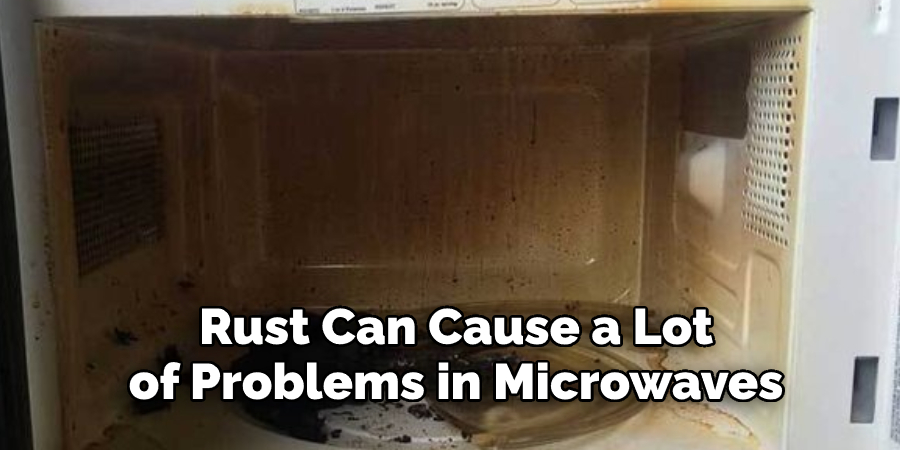
If you’ve ever eaten food that’s been cooked in a rusty microwave, you know how unpleasant it can be. Rust can also cause your food to smell bad. Finally, rust can be a health hazard. If you ingest rust, it can make you sick. It can also cause allergic reactions in some people. For all these reasons, it’s important to fix rust inside microwaves.
10 Ways How to Fix Rust Inside Microwave
1. Use Vinegar
One of the best ways to remove rust is with vinegar. Vinegar is a natural acid that will eat away at the rust. Mix equal parts vinegar and water in a bowl to use this method. Then, submerge a clean cloth in the mixture and use it to scrub the rust. This may take a few minutes of scrubbing to work. If the rust is really bad, you may need to let the vinegar sit on the rust for a few minutes before scrubbing.
2. Use Lemon Juice
Lemon juice is another natural acid that can remove rust. This method will take some time, but it is effective. First, mix equal parts lemon juice and water. Then, soak a sponge in the mixture and use it to scrub away the rust. If the rust is stubborn, you can try using full-strength lemon juice. Apply it to the rust and let it sit for several hours before scrubbing. You may need to repeat this process a few times to remove all the rust.
3. Use Baking Soda
Baking soda is a natural cleaning agent that can also remove rust. This method is best used on small rust spots. To use this method, first, make a paste by mixing baking soda with water. Next, apply the paste to the rust spots and let it sit for 10-15 minutes. Finally, use a clean cloth to wipe away the paste and rust. If necessary, repeat this process until the rust spots are gone.
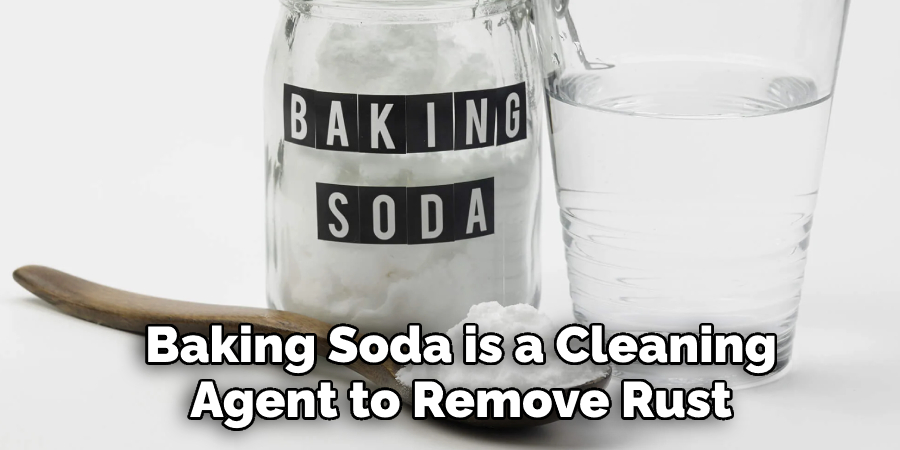
4. Use Rust Remover
If you can’t get the rust out with natural cleaners, you may need to use a rust remover. There are many different rust removers on the market, so be sure to choose one that is safe for use on microwaves. First, make sure that the area you are treating is well-ventilated. Next, follow the instructions on the rust remover product. Once the rust has been removed, be sure to rinse the area well with water and dry it completely. If the rust stain is still visible, you may need to repeat this process.
5. Use Steel Wool
If you have steel wool, you can use it to remove rust from your microwave. This method is best used on small rust spots. First, wet the steel wool with water and then rub it over the rust spot. You should see the rust coming off onto the steel wool. Once you have removed all of the rust, dry the area with a clean cloth. If you don’t have steel wool, you can also use a stiff brush to scrub the rust off. This method will take a bit more elbow grease, but it will still get the job done.
6. Use sandpaper
If the rust is really stubborn, you may need to use sandpaper to remove it. This method should only be used as a last resort because it can damage the surface of your microwave. First, make sure the area is completely dry. Then, use low-grit sandpaper to gently sand away the rust. Be sure to sand in the same direction as the metal’s grain. Once the rust is gone, wipe away any debris with a clean cloth.
7. Use Aluminum Foil
If you have aluminum foil, you can use it to remove rust from your microwave. This method is best used on small rust spots. Cut a small piece of aluminum foil and place it over the rust spot.
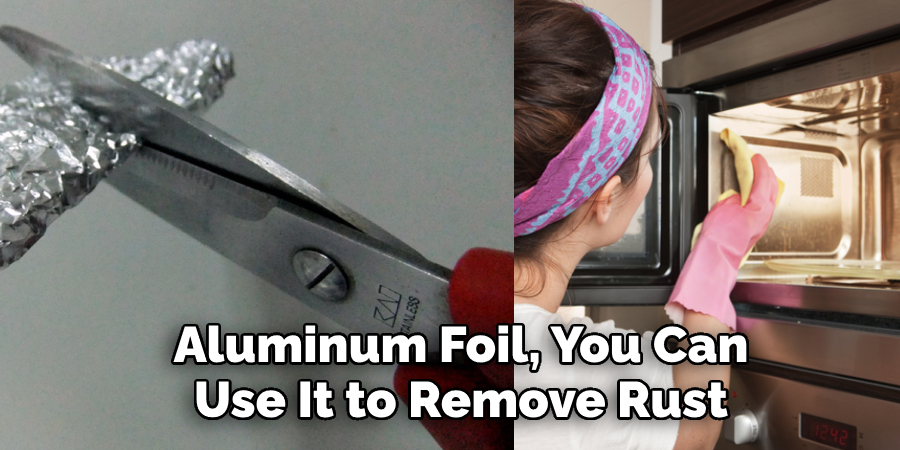
Use a scrubbing pad to rub the foil over the rust spot. The rust will transfer to the foil. After you have removed the rust, wipe down the area with a damp cloth.
8. Use Water and Soap
If the rust spot is small, you may be able to remove it with water and soap. First, wet the rust spot with water. Then, add a drop of dish soap to the wet spot. Finally, use a toothbrush or other soft brush to scrub the rust away. If the rust does not come off easily, you may need to use a stronger rust removal solution.
9. Use Wd-40
If you have WD-40, you can use it to remove rust from your microwave. This method is best used on small rust spots. First, unplug your microwave and remove any food or other items from the inside. Next, spray the WD-40 onto a clean cloth and rub it onto the rust spot. You should see the rust start to come off immediately. Once the rust is gone, wipe down the area with a damp cloth to remove any WD-40 residue.
10. Replace the Rusty Part
If the rust spot is too large or too deep, you may need to replace the rusty part. This is generally a last resort, as it can be expensive and time-consuming. But if the rust prevents your microwave from functioning properly, it may be your only option. First, you’ll need to find a replacement part that fits your microwave. You can usually find these online or at a specialty appliance store. Once you have the part, follow your microwave manual instructions to replace it. With any luck, this will take care of the rust problem, and you can continue using your microwave without any issues.
How to Prevent Rust in the Microwave
You can do a few things to prevent rust from forming in your microwave. First, make sure to clean the inside of your microwave regularly. Wipe down the walls and ceiling with a damp cloth or sponge. Be sure to get into all of the nooks and crannies, as rust can form in any crevice. Second, try to avoid leaving wet or damp items inside your microwave. If you need to store wet items in the microwave, dry them off first.
Additionally, try to avoid using metal utensils or containers inside the microwave. If you do use metal, make sure it doesn’t come into contact with the walls or ceiling of the microwave. Another good way to prevent rust is to use a rust-resistant coating on the inside of your microwave. This can be found at most hardware stores. Simply apply the coating to the inside of your microwave, which will help prevent rust from forming. Finally, make sure to unplug your microwave when it’s not in use. This will help to prevent rust from forming on the electrical components.
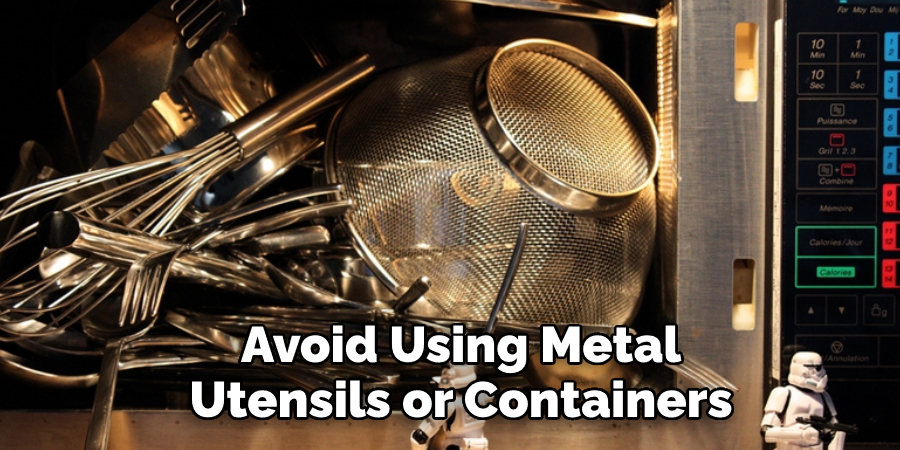
How Often Should You Clean the Microwave?
It would be best if you cleaned your microwave at least once a week. If you use it more often, you may need to clean it more frequently. Be sure to wipe down the inside of the microwave after each use. This will help to prevent rust from forming. Normally, a weekly cleaning should be sufficient. But if you notice rust starting to form, you may need to clean it more often.
Frequently Asked Questions
Can You Fix Rust in a Microwave?
Rust is a common problem in microwaves and can be difficult to remove. However, there are a few simple steps that you can follow to try and fix it. The first step is to power off the microwave and unplug it from the wall before beginning any repairs. Next, take out all of your food items and place them on some newspapers or towels so that they don’t touch any metal parts of the microwave.
Now, use an SOS pad or spoon to cover as much surface area of rust as possible with hot water while continuously scrubbing with soap. Once all areas have been treated, dry the surfaces thoroughly before re-installing your food items into the oven cavity. Remember to run cold water over everything twice before plugging it into your microwave!
Can I Repaint the Inside of My Microwave?
Unfortunately, the answer to this question is no. Microwaves are designed to be painted or refinished in a very specific way – by removing the outer coating and refinishing the metal. This is not something that can be done by the average homeowner.
Is It Safe to Use a Microwave That Has Peeling Paint Inside?
Using a microwave that has peeling paint may not be the best idea. According to reports, this type of Microwave can cause short-term health problems like skin cancer and genetic damage. Additionally, it could damage your oven’s seals which could lead to moisture entering and causing more damage. So if you’re in doubt about whether or not to use your Microwave, err on the side of caution and avoid it until the paint has been properly repaired or replaced.
When Should You Replace Your Microwave?
Especially if it’s starting to give you trouble. Here are some tips on when to replace your microwave:
- If the power has been going out frequently – This is probably the most obvious sign that it’s time to replace your microwave. If you’re always losing power, it’s probably not worth the risk of using a potentially dangerous appliance.
- If the microwave is becoming difficult to use – When you turn it on, it might take a while for it to heat up or preheat. This could be because the fan has stopped working or because the heating element isn’t working as efficiently as it used to. In either case, it might be best to get a new microwave.
- If the microwave is making weird noises or smells weird – Microwaves tend to produce high levels of heat and noise, which can damage parts over time. If you notice that anything is starting to go wrong with your microwave, don’t hesitate to replace it immediately!
Conclusion
So there you have it! Everything you need to know about how to fix rust inside microwave. Be sure to follow these steps carefully; your microwave will look new in no time. We hope you found this article helpful. Thanks for reading!
You Can Check it Out to Fix Microwave Tripping Circuit Breaker
